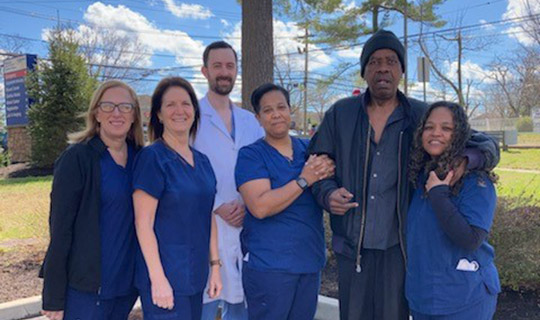The wound care center got me through this. They really took care of me.

Specialized care helps a man with diabetes recover from severe infections and wounds.
Barry Sutton of Lakewood knew he had diabetes, but he didn’t realize how extreme the disease’s complications could become. In September 2021, his blood sugar was out of control. But it’s the nature of diabetes that symptoms often go unnoticed until they become severe.
Sutton’s cousin was the first to sound an alarm. Sutton had mentioned he was having foot pain while they were together one weekend. “She said, ‘You better get that checked out,’” he says.
When he took her advice, his doctor pointed out something alarming. “He noticed my little toe was kind of black,” Sutton recalls. “He said I should go to the hospital.”
Threatening Wounds
At Monmouth Medical Center Southern Campus (MMCSC), doctors understood immediately what was happening. “He had a severe, aggressive diabetic foot infection,” says Matthew Modugno, DPM, a podiatrist at MMCSC. “It was very significant and could have progressed to a limb- or even life-threatening situation.”
It was already too late to save two of Sutton’s toes. The day he came to the hospital, Amanda Crowell, DPM, a podiatrist at MMCSC, performed surgery to amputate Sutton’s fourth and fifth digits, along with a portion of the metatarsal bones behind each toe.
“I’m lucky,” Sutton says. “You have to look at it that way. I lost two toes, but there’s always somebody in worse shape than you. You just have to keep going.”
In addition to his infected toes, Sutton had a large wound on his heel. He needed to not only control infection but also heal the wound and address the underlying problems that were wreaking havoc with his lower extremities.
Removing the severely infected toes was just the start of Sutton’s long journey back to more stable health. “We threw a wide variety of services into the battle, including teams addressing internal medicine, infectious disease, cardiology, interventional cardiology and wound care,” Dr. Modugno says.
Extensive Treatment
Tests including X-rays, MRI scans and studies of Sutton’s blood flow revealed that his problems were extensive. A few days after his first surgery, he underwent a second surgery to remove more bone along with dead or nonviable tissue in hopes of further controlling infection, closing the surgical site and helping his wounds heal.
In a technique called negative pressure therapy, a vacuum device helped draw fluid from Sutton’s wounds and increase blood flow to the area. “Negative pressure basically encourages wound healing from the bottom up and helps make the base of the wound healthier,” Dr. Modugno says. “You don’t want a deep, wide-open space.”
Within days, Sutton also had a vascular procedure that opened up blocked blood vessels in his leg to improve circulation. All told, he was in the hospital for more than a week.
But Sutton’s care didn’t end with his discharge. He continued to receive skilled wound care and extensive treatment at MMCSC’s Center for Wound Healing and Hyperbaric Medicine.
Samples of bone removed during surgery found he had a residual bone infection, so he went home with a PICC (peripherally inserted central catheter) line that allowed him to receive infusions of intravenous antibiotics for six weeks.
“We also quickly evaluated him for hyperbaric oxygen [HBO] therapy, which is indicated for diabetic foot wounds and bone infection,” Dr. Modugno says.
HBO therapy entails lying in a pressurized chamber to receive pure oxygen that helps fight bacteria and heal wounds. Sutton went through dozens of sessions, each lasting two hours or more.
“Some people couldn’t stand to be closed in,” Sutton says. “But the staff at the wound care center kept me occupied or helped me laugh or watch TV to get me through. They’re good people over there.”
For months, Sutton came in regularly to have wounds cleaned and bound with a variety of dressings. He also was fitted with orthotic shoes.
“It’s very important to have proper shoes that accommodate the new foot structure and properly distribute pressure to reduce the chances of recurrence,” Dr. Modugno says.
Compression socks help improve Sutton’s circulation. Sutton’s wounds gradually healed, and his visits became less frequent.
“Eventually, he was wound-free, had no evidence of infection and was able to independently walk on his own,” Dr. Modugno says.
By spring 2022, Dr. Modugno was down to seeing Sutton monthly.
“It could have been worse,” Sutton says. “The wound care center got me through this. They really took care of me.”
Why Is Diabetes So Dangerous?Having diabetes seems a far cry from needing a toe or leg removed. But wounds and infections severe enough to require amputation can be an unfortunate consequence of having poorly controlled blood sugar. Diabetes is a chronic disease that occurs when the body has trouble producing or responding to the hormone insulin, which delivers blood sugar, or glucose, into cells for energy. If the body can’t use enough insulin, glucose builds in the bloodstream. High blood sugar can increase risks for a variety of serious complications. These include heart attack and other forms of cardiovascular disease, nerve damage and circulation problems. Poor circulation and nerve damage can make feet vulnerable to wounds and sores that can quickly get worse and often have difficulty healing. |
To learn more about treatment at the Center for Wound Healing and Hyperbaric Medicine at Monmouth Medical Center Southern Campus or to make an appointment, call 732-886-4100.